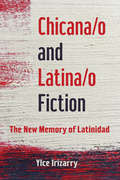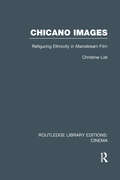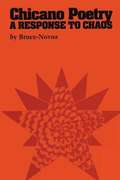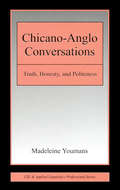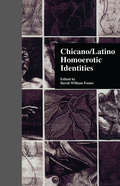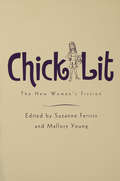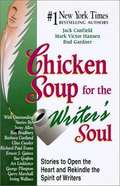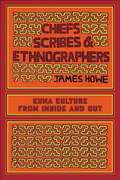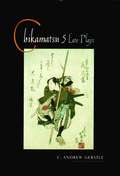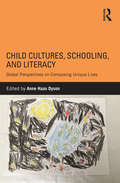- Table View
- List View
Chicago: A Literary History
by Frederik Byrn KøhlertChicago occupies a central position in both the geography and literary history of the United States. From its founding in 1833 through to its modern incarnation, the city has served as both a thoroughfare for the nation's goods and a crossroads for its cultural energies. The idea of Chicago as a crossroads of modern America is what guides this literary history, which traces how writers have responded to a rapidly changing urban environment and labored to make sense of its place in - and implications for - the larger whole. In writing that engages with the world's first skyscrapers and elevated railroads, extreme economic and racial inequality, a growing middle class, ethnic and multiethnic neighborhoods, the Great Migration of African Americans, and the city's contemporary incarnation as a cosmopolitan urban center, Chicago has been home to a diverse literature that has both captured and guided the themes of modern America.
Chicana/o Remix: Art and Errata Since the Sixties
by Karen Mary DavalosRewrites our understanding of the last 50 years of Chicana/o cultural production. Chicana/o Remix casts new light not only on artists—such as Sandra de la Loza, Judy Baca, and David Botello, among others—but on the exhibitions that feature their work, and the collectors, curators, critics, and advocates who engage it. Combining feminist theory, critical ethnic studies, art historical analysis, and extensive archival and field research, Karen Mary Davalos argues that narrow notions of identity, politics, and aesthetics limit our ability to understand the full capacities of Chicana/o art. She employs fresh vernacular concepts such as the “errata exhibit,” or the staging of exhibits that critically question mainstream art museums, and the “remix,” or the act of bringing new narratives and forgotten histories from the background and into the foreground. These concepts, which emerge out of art practice itself, drive her analysis and reinforce the rejection of familiar narratives that evaluate Chicana/o art in simplistic, traditional terms, such as political versus commercial, or realist versus conceptual. Throughout Chicana/o Remix, Davalos explores undocumented or previously ignored information about artists, their cultural production, and the exhibitions and collections that feature their work. Each chapter exposes and challenges conventions in art history and Chicana/o studies, documenting how Chicana artists were the first to critically challenge exhibitions of Chicana/o art, tracing the origins of the first Chicano arts organizations, and highlighting the influence of Europe and Asia on Chicana/o artists who traveled abroad. As a leading scholar in the study of Chicana/o artists, art spaces, and exhibition practices, Davalos presents her most ambitious project to date in this re-examination of fifty years of Chicana/o art production.
Chicana/o Subjectivity And The Politics Of Identity
by Carlos GallegoThis book traces the influence of Hegel's theory of recognition on different literary representations of Chicano/a subjectivity, with the aim of demonstrating how the identity thinking characteristic of Hegel's theory is unwillingly reinforced even in subjects that are represented as rebelling against liberal-humanist ideologies.
Chicana/o and Latina/o Fiction: The New Memory of Latinidad
by Ylce IrizarryIn this new study, Ylce Irizarry moves beyond literature that prioritizes assimilation to examine how contemporary fiction depicts being Cuban, Dominican, Mexican, or Puerto Rican within Chicana/o and Latina/o America. Irizarry establishes four dominant categories of narrative--loss, reclamation, fracture, and new memory--that address immigration, gender and sexuality, cultural nationalisms, and neocolonialism. As she shows, narrative concerns have moved away from the weathered notions of arrival and assimilation. Contemporary Chicana/o and Latina/o literatures instead tell stories that have little, if anything, to do with integration into the Anglo-American world. The result is the creation of new memory. This reformulation of cultural membership unmasks the neocolonial story and charts the conscious engagement of cultural memory. It outlines the ways contemporary Chicana/o and Latina/o communities create belonging and memory of their ethnic origins.
Chicano Images: Refiguring Ethnicity in Mainstream Film (Routledge Library Editions: Cinema)
by Christine ListProviding textual analysis of 12 feature films written and directed by filmmakers who explore aspects of the Chicano cultural movement, this book discusses films including Cheech and Chong's Still Smokin' (1983), El Norte (1985), and Break of Dawn (1988). The text analyzes the portrayal of Chicano, or Mexican American, identity in films by chicanos. Part historiography, part film analysis, part ethnography, this book offers a compelling story of how Chicanos challenge, subvert and create their own popular portrayals of Chicanismo. Historical stereotypical images in Hollywood films are discussed alongside contemporary images portrayed by Hollywood studios and independent Chicano filmmakers. The author examines the way in which newer films "construct new representations of Chicano culture" and present a greater variety of images of Chicanos for mainstream audiences. Originally published in 1996, this authoritative volume provides a full history of the Chicano cultural movement beginning in the 1960s as well as information on the development of Mexican American film production.
Chicano Poetry: A Response to Chaos
by Bruce-NovoaAlurista. Gary Soto. Bernice Zamora. José Montoya. These names, luminous to some, remain unknown to those who have not yet discovered the rich variety of late twentieth century Chicano poetry. With the flowering of the Chicano Movement in the mid-1960s came not only increased political awareness for many Mexican Americans but also a body of fine creative writing. Now the major voices of Chicano literature have begun to reach the wider audience they deserve. Bruce-Novoa's Chicano Poetry: A Response to Chaos-the first booklength critical study of Chicano poetry-examines the most significant works of a body of literature that has grown dramatically in size and importance in less than two decades. Here are insightful new readings of the major writings of Abelardo Delgado, Sergio Elizondo, Rodolfo Gonzales, Miguel Méndez, J. L. Navarro, Raúl Salinas, Ricardo Sánchez, and Tino Villanueva, as well as Alurista, Soto, Zamora, and Montoya. Close textual analyses of such important works as I Am Joaquín, Restless Serpents, and Floricanto en Aztlán enrich and deepen our understanding of their imagery, themes, structure, and meaning. Bruce-Novoa argues that Chicano poetry responds to the threat of loss, whether of hero, barrio, family, or tradition. Thus José Montoya elegizes a dead Pachuco in "El Louie," and Raúl Salinas laments the disappearance of a barrio in "A Trip through the Mind Jail. " But this elegy at the heart of Chicano poetry is both lament and celebration, for it expresses the group's continuing vitality and strength. Common to twentieth-century poetry is the preoccupation with time, death, and alienation, and the work of Chicano poets-sometimes seen as outside the traditions of world literature-shares these concerns. Bruce-Novoa brilliantly defines both the unique and the universal in Chicano poetry.
Chicano-Anglo Conversations: Truth, Honesty, and Politeness (ESL & Applied Linguistics Professional Series)
by Madeleine YoumansThis groundbreaking book--about differences in communication practices between Mexican-American underclass residents in an East Los Angeles housing project and white, middle-class literacy tutors who worked with them--makes an important contribution to research on the sociolinguistics of the Chicano gang culture. More specifically, this work adds substantially to research on understanding linguistic politeness theories, the use of epistemic modals for negative politeness, and evidentiality. It refines, and in a number of cases, defines, function categories for epistemic modals through a rigorous grammatical analysis. This book is also distinctive in that the author subjects the language of middle-class Anglos to the same type of scrutiny that is often reserved for non-mainstream groups. Youmans contends that the differences between the Chicano and Anglo speakers are the result of the two groups’ different sociocultural circumstances, including historical and current living and working patterns and the relative value placed on familialism and communalism versus individualism and independence. (The terms Chicano and Anglo are used as a kind of shorthand in this book--not to raise larger sociocultural issues implied by these terms.) Although the number of participants in the study limits the applicability of the findings as they might be extrapolated to all Chicanos/as, or all Anglos when reporting sociolinguistic observations, the main argument advanced is that language use may provide insights into beliefs, attitudes, and practices in the larger society. This volume is directed to researchers and graduate students in the areas of sociolinguistics, applied linguistics, discourse analysis, and cross-cultural communication, and will also interest language and linguistics educators and grammarians.
Chicano/Latino Homoerotic Identities
by David W. FosterThis collection, which grew out of a research conference held at Arizona State Universoty in November 1997, examines varieties of Chicano/Latino homoerotic identities. It includes essays by a group of scholars who are engaged in defining the parameters of these identities and who are concerned with how those identities interact with the dominate ones articulated by a hegemonic Anglo society in the United States.
Chick Lit and Postfeminism
by Stephanie HarzewskiOriginally a euphemism for Princeton University's Female Literary Tradition course in the 1980s, "chick lit" mutated from a movement in American women's avant-garde fiction in the 1990s to become, by the turn of the century, a humorous subset of women's literature, journalism, and advice manuals. Stephanie Harzewski examines such best sellers as Bridget Jones's Diary The Devil Wears Prada, and Sex and the City as urban appropriations of and departures from the narrative traditions of the novel of manners, the popular romance, and the bildungsroman. Further, Harzewski uses chick lit as a lens through which to view gender relations in U.S. and British society in the 1990s. Chick Lit and Postfeminism is the first sustained historicization of this major pop-cultural phenomenon, and Harzewski successfully demonstrates how chick lit and the critical study of it yield social observations on upheavals in Anglo-American marriage and education patterns, heterosexual rituals, feminism, and postmodern values.
Chick Lit: The New Woman's Fiction
by Mallory Young Suzanne FerrissFrom the bestselling Bridget Jones's Diary that started the trend to the television sensation Sex and the City that captured it on screen, "chick lit" has become a major pop culture phenomenon. Banking on female audiences' identification with single, urban characters who struggle with the same life challenges, publishers have earned millions and even created separate imprints dedicated to the genre. Not surprisingly, some highbrow critics have dismissed chick lit as trashy fiction, but fans have argued that it is as empowering as it is entertaining.This is the first volume of its kind to examine the chick lit phenomenon from a variety of angles, accounting for both its popularity and the intense reactions-positive and negative-it has provoked. The contributors explore the characteristics that cause readers to attach the moniker "chick" to a particular book and what, if anything, distinguishes the category of chick lit from the works of Jane Austen on one end and Harlequin romance novels on the other. They critique the genre from a range of critical perspectives, considering its conflicted relationship with feminism and postfeminism, heterosexual romance, body image, and consumerism. The fourteen original essays gathered here also explore such trends and subgenres as "Sistah Lit," "Mommy Lit," and "Chick Lit Jr.," as well as regional variations. As the first book to consider the genre seriously, Chick Lit offers real insight into a new generation of women's fiction.
Chicka Chicka Boom Boom
by John Archambault Lois Ehlert Bill MartinA told B, and B told C, I'll meet you at the top of the coconut tree. In this lively alphabet rhyme, all the letters of the alphabet race each other up the coconut tree. Will there be enough room? Oh, no - Chicka Chicka Boom! Boom! The well-known authors of Barn Dance and Knots on a Counting Rope have created a rhythmic alphabet chant that rolls along on waves of fun. Lois Ehlert's rainbow of bright, bold, cheerful colors makes the merry parade of letters unforgettable.
Chicka Chicka Ho Ho Ho (Chicka Chicka Book, A)
by William Boniface<b>A New York Times Bestseller</b> <p> In a much-anticipated new companion to the beloved and bestselling classic Chicka Chicka Boom Boom, the rollicking alphabet chant gets a holiday twist. A told B, and B told C, “I’ll meet you in the branches of the Christmas tree.” In this holiday alphabet rhyme, the crew of beloved letters gets their chance to shine as decorations on the Christmas tree!
Chicken Soup for the Soul: Inspiration for Writers
by Jack Canfield Mark Victor Hansen Amy Newmark Susan M. HeimWith 101 stories from published writers who stuck with it and succeeded, you will be inspired and encouraged, whether you're an aspiring author, a blogger, or a bestselling writer.No matter the genre, no matter the medium, the writing process is hard! But you will find inspiration, encouragement, and advice in these 101 stories from others who have stuck with it, through the setbacks and struggles, and successfully went from dreaming about writing to being a writer.
Chicken Soup for the Writer's Soul
by Jack Canfield Mark Victor Hansen Bud GardnerBeing a writer can be a lonely and frustrating experience. The stories in this book--by a wide range of professional writers, novelists, journalists, freelancers, poets, and screenwriters--will give readers insight into the human trials, tribulations, and triumphs of writers, and writers a source of inspiration and commiseration. Whether readers are beginning writers, seasoned pros, or wannabes, the stories of purpose, passion, endurance, and success contained in Chicken Soup for the Writer's Soul will inform, entertain, uplift, and inspire them. In its pages, they will learn important lessons on: the importance of perseverance, the value of being yourself, the process of discovering your own voice, the need for mentors and allies, and the power of following your heartfelt dreams. Contributors include: Sue Grafton, Steve Allen, Dave Barry, Agatha Christie, Art Linkletter, Terry McMillan, and more.
Chicken Soup for the Writer's Soul: Stories to Open the Heart and Rekindle the Spirit of Writers
by Jack Canfield Mark Victor Hansen Bud GardnerThis is a collection of essays by familiar and unfamiliar writers of stage plays, screen plays, sport columns, short stories, comedy routines, newspaper and magazine articles, cartoons and novels, from romance to adventure, to detective. They open their hearts to would be writers covering the spectrum of the writing experience. from its lowest ebb to the apex of its successes. You will read about writers low on money and high on rejection slips. Some of the record breaking best selling writers of all time describe their bulging file folders of hundreds of rejection letters. As you read their essays you'll feel as if you met them, spent quality, one on one time with them. Discover how a mother writes romance with a houseful of bickering kids vying for attention, how a sports writer risks his life and breaks his limbs to participate in the sports he writes about first hand. Walk beside untried writer hopefuls who meet their author heroes like the genuinely warm and generous Alex Haley and the outspoken, brilliant Sinclair Lewis. You'll see that success is often built on failure as was the experience of the author of Sleepless in Seattle, whose first play was viciously attacked by critics and closed after one performance. Ray Bradbury writes a beautifully poetic ode to the joy of lifelong reading declaring that you must read what you like, not what you are told to or expected to read. He promises that what you read contributes to who you will become. Sue Grafton confides that she is living her father's dream as well as her own. He taught her the groundwork for becoming a successful author while denying himself that dream. Whether you sample the articles that call to you, or read this wonderful collection of heartfelt, first hand experiences with the writing process, you will learn, be amused and moved and deeply enjoy and appreciate every word, every page, every meeting with every author. Cartoons are included and described.
Chicken Soup for the Writer's Soul: Stories to Open the Heart and Rekindle the Spirit of Writers
by Jack Canfield Mark Victor Hansen Bud GardnerBeing a writer can be a lonely and frustrating experience. The stories in this book--by a wide range of professional writers, novelists, journalists, freelancers, poets, and screenwriters--will give readers insight into the human trials, tribulations, and triumphs of writers, and writers a source of inspiration and commiseration. Whether readers are beginning writers, seasoned pros, or wannabes, the stories of purpose, passion, endurance, and success contained in Chicken Soup for the Writer's Soul will inform, entertain, uplift, and inspire them. In its pages, they will learn important lessons on: the importance of perseverance, the value of being yourself, the process of discovering your own voice, the need for mentors and allies, and the power of following your heartfelt dreams. Contributors include: Sue Grafton, Steve Allen, Dave Barry, Agatha Christie, Art Linkletter, Terry McMillan, and more.
Chicken Soup with Rice: A Book of Months
by Maurice Sendak"In August it will be so hot I will become a cooking pot cooking soup of course. Why not? Cooking once cooking twice cooking chicken soup with rice. ..."
Chiefs, Scribes, and Ethnographers
by James HoweThe Kuna of Panama, today one of the best known indigenous peoples of Latin America, moved over the course of the twentieth century from orality and isolation towards literacy and an active engagement with the nation and the world. Recognizing the fascination their culture has held for many outsiders, Kuna intellectuals and villagers have collaborated actively with foreign anthropologists to counter anti-Indian prejudice with positive accounts of their people, thus becoming the agents as well as subjects of ethnography. One team of chiefs and secretaries, in particular, independently produced a series of historical and cultural texts, later published in Sweden, that today still constitute the foundation of Kuna ethnography. As a study of the political uses of literacy, of western representation and indigenous counter-representation, and of the ambivalent inter-cultural dialogue at the heart of ethnography, Chiefs, Scribes, and Ethnographers addresses key issues in contemporary anthropology. It is the story of an extended ethnographic encounter, one involving hundreds of active participants on both sides and continuing today.
Chikamatsu: Five Late Plays (Translations from the Asian Classics #No. 116)
by ChikamatsuChikamatsu Monzaemon (1653-1725), often referred to as "Japan's Shakespeare" and a "god of writers," was arguably the most famous playwright in Japanese history and wrote more than 100 plays for the kabuki and bunraku theaters. Today, the plays of this major literary figure are performed on kabuki and bunraku stages as well as in the modern theater, and forty-nine films of his plays have been made, thirty-one of them from the silent era.Translations of Chikamatsu's plays are available, but we have few examples of his late work, in which he increasingly incorporated stylistic elements of his shorter, contemporary dramas into his longer period pieces. Translator C. Andrew Gerstle argues that in these mature history plays, Chikamatsu depicted the tension between the private and public spheres of society by combining the rich character development of his contemporary pieces with the larger political themes of his period pieces. In this volume Gerstle translates five plays—four histories and one contemporary piece—never before available in English that complement other collections of Chikamatsu's work, revealing new dimensions to the work of this great Japanese playwright and artist.
Child Autonomy and Child Governance in Children's Literature: Where Children Rule (Children's Literature and Culture)
by Christopher Kelen Bjorn SundmarkThis book explores representations of child autonomy and self-governance in children’s literature.The idea of child rule and child realms is central to children’s literature, and childhood is frequently represented as a state of being, with children seen as aliens in need of passports to Adultland (and vice versa). In a sense all children’s literature depends on the idea that children are different, separate, and in command of their own imaginative spaces and places. Although the idea of child rule is a persistent theme in discussions of children’s literature (or about children and childhood) the metaphor itself has never been properly unpacked with critical reference to examples from those many texts that are contingent on the authority and/or power of children. Child governance and autonomy can be seen as natural or perverse; it can be displayed as a threat or as a promise. Accordingly, the "child rule"-motif can be seen in Robinsonades and horror films, in philosophical treatises and in series fiction. The representations of self-ruling children are manifold and ambivalent, and range from the idyllic to the nightmarish. Contributors to this volume visit a range of texts in which children are, in various ways, empowered, discussing whether childhood itself may be thought of as a nationality, and what that may imply. This collection shows how representations of child governance have been used for different ideological, aesthetic, and pedagogical reasons, and will appeal to scholars of children’s literature, childhood studies, and cultural studies.
Child Cultures, Schooling, and Literacy: Global Perspectives on Composing Unique Lives
by Anne Haas DysonThrough analysis of case studies of young children (ages 3 to 8 years), situated in different geographic, cultural, linguistic, political, and socioeconomic sites on six continents, this book examines the interplay of childhoods, schooling, and, literacies. Written language is situated within particular childhoods as they unfold in school. A key focus is on children’s agency in the construction of their own childhoods. The book generates diverse perspectives on what written language may mean for childhoods. Looking at variations in the complex relationships between official (curricular) visions and unofficial (child-initiated) visions of relevant composing practices and appropriate cultural resources, it offers, first, insight into how those relationships may change over time and space as children move through early schooling, and, second, understanding of the dynamics of schools and the experience of childhoods through which the local meaning of school literacy is formulated. Each case—each child in a particular sociocultural site—does not represent an essentialized nation or a people but, rather, a rich, processual depiction of childhood being constructed in particular local contexts and the role, if any, for composing.
Child Language
by Jean Stilwell PecceiBuilding on the established strengths of the first edition, Child Language has now been fully updated and includes some basic theory content, more exercises and summaries at the end of each unit. Child Language:* introduces students to key areas involved in the study of children's language: vocabulary development, word and sentence structure, conversational skills and pronunciation* contains a corpus of children's language* includes suggestions for project work.
Child Work and Education: Five Case Studies from Latin America (Routledge Revivals)
by María Cristina Salazar Walter Alarcón GlasinovichPublished in 1998. In recent years research, as well as the results of practical programmes, has led to a clearer understanding of the relationship between child work and education. It is increasingly evident that child work is not entirely the result of economic need or exploitation. Frequently is the failure of educational system to offer adequate, stimulating and affordable schooling that encourages children to drop out in favour of work that appears to offer advantages more relevant to their everyday lives. Parents too may undervalue the role and purpose of a school that provides inadequate preparation for the future and often see a job, including home-based work, as a positive alternative to crime, delinquency or begging. Consequently, while a distinction needs to be made between ‘formative child work’ and ‘harmful child work’, in certain situations and cultures the phenomenon is not always seen as negative. Yet, although gratifying in the short term and sometimes even providing the means for a younger child to attend school as well as a way of learning discipline and responsibility, often these jobs provide no useful experience and do not lead to an improvement in the personal development of life chances of a child. The situation is therefore complex and requires a more realistic evolution of the relationship between archaic pedagogy, dropout rates and child work. These five case studies from Latin America all reveal the effects of inappropriate school curricular. Desertion of the educational system for the labour market leads to inadequate training and perpetuates the poverty trap. As part of the commitment to combating work which is detrimental to the child, major educational reform is needed. Improvements in coverage, quality and affordability should lead to greater acceptance pf schooling at all levels of society and provide a greater incentive for parents and children alike to participate more fully in the system. Moreover, in cases of severe economic hardship and forced or harmful labour, practical assistance with subsides and scholarships should be considered to remove children from such work.



